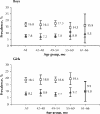Prevalence of overweight and obesity in a provincial population of Canadian preschool children
- PMID: 15289421
- PMCID: PMC490073
- DOI: 10.1503/cmaj.1040075
Prevalence of overweight and obesity in a provincial population of Canadian preschool children
Abstract
Background: More and more school-aged children in Canada and elsewhere are becoming overweight or obese. Many countries are now reporting a similar trend among preschool children. However, little information is available on the prevalence of overweight and obesity among preschool children in Canada. In addition, available data are based on reported rather than measured heights and weights. We conducted this study to determine the prevalence of overweight and obesity, using measured heights and weights, in the 1997 cohort of children aged 3-5 years born in Newfoundland and Labrador.
Methods: We calculated the body mass indices (BMIs) using heights and weights measured by public health nurses during the province-wide Preschool Health Check Program conducted between October 2000 and January 2003. Descriptive data on the children's BMIs and prevalence estimates were generated and analyzed by sex and age with the use of the classification system recommended by the International Obesity Task Force.
Results: Data were available for 4161 of the 5428 children born in 1997; boys and girls were equally represented (50.1% and 49.9% respectively). Overall, 25.6% of the preschool children in the cohort were overweight or obese. The rates did not differ significantly by sex or age group.
Interpretation: These results indicate that a high proportion of children aged 3-5 years in Newfoundland and Labrador are overweight or obese. It appears that prevention measures should begin before the age of 3 years.
Figures
Comment in
-
Early childhood obesity: a call for early surveillance and preventive measures.CMAJ. 2004 Aug 3;171(3):243-4. doi: 10.1503/cmaj.1040938. CMAJ. 2004. PMID: 15289422 Free PMC article. No abstract available.
-
Definitions of pediatric obesity.CMAJ. 2005 Feb 1;172(3):309-10; author reply 310-1. doi: 10.1503/cmaj.1041328. CMAJ. 2005. PMID: 15684099 Free PMC article. No abstract available.
References
-
- Tremblay MS, Katzmarzyk PT, Willms JD. Temporal trends in overweight and obesity in Canada, 1981–96. Int J Obes Relat Metab Disord 2002;26(4):538-43. - PubMed
-
- Magarey AM, Daniels LA, Boulton TJ. Prevalence of overweight and obesity in Australian children and adolescents: reassessment of 1985 and 1995 data against new standard international definitions. Med J Aust 2001;174:561-4. - PubMed
-
- The Surgeon General's call to action to prevent and decrease overweight and obesity. Rockville (MD): US Department of Health and Human Services, Public Health Service, Office of the Surgeon General; 2001. - PubMed
-
- Ogden C, Flegal K, Carroll M, Johnson C. Prevalence and trends in overweight among US children and adolescents, 1999–2000. JAMA 2002; 288 (14): 1728-32. - PubMed
Publication types
MeSH terms
LinkOut - more resources
Full Text Sources
Medical

